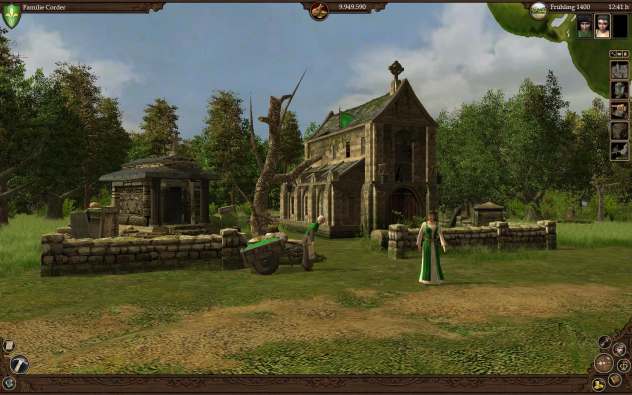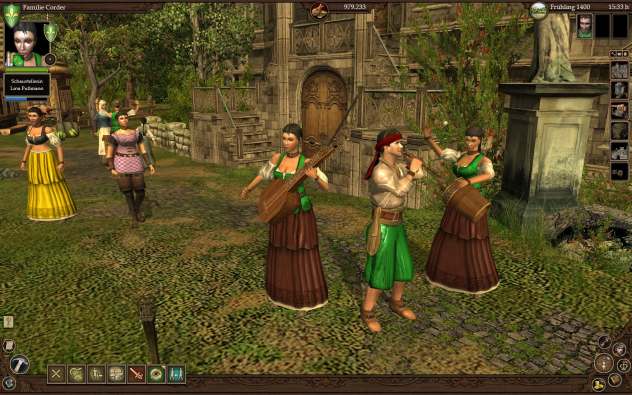
Most of my gaming in recent times has been console based, so the opportunity to have a detailed look at JoWood’s Guild 2 Renaissance on the PC interested me. As it turns out, I suspect I’m not quite cut out for PC based gaming, even if those games are actually pretty good.
PC gamers are a different breed to those who mainly use a console. Games can last months, years even without anyone flinching. Gamers spend hundreds of pounds buying the latest equipment to keep up to speed, and if the early stages of Renaissance are anything to go buy they also have intelligence far beyond anything I can come up with. You see, with being a standalone expansion to the original Guild 2, Renaissance has a limited manual which just tells you what’s new since last time round. So what if this is your first Guild game, as it was for me? Surely the in-game tutorial that every game has nowadays will help… well… no. There isn’t one. Instead of a nice hand-holding experience you get dropped into the game and told to get on with it. Sure you get a few tips along the way, but for someone new to the genre telling me to “get involved in politics” doesn’t help without telling me HOW to get involved. Still, there’s no reward without effort so I dug my heels in and got cracking.
There’s no denying that the game environment looks and sounds good. Obviously the visuals will depend on the hardware you’ve got under the hood but even at lower resolutions the worlds look nice, changing with the seasons and impressively crisp even when fully zoomed in. Each different map also reflects its location nicely, with England, Italy and other places offering a stark contrast in visual styles. Equally as impressive is the sound, especially the music which couples with the renaissance theme perfectly to give a far more atmospheric experience. There are a few issues though, mainly with characters and scenery interacting in a strange way. On several occasions a goods cart has been pulled through a fence, and people walk through buildings as if they’re not there. I also had a comedy moment in a bar when a random character was walking in endless circles around a female patron. It’s nothing criminal but it’s a bit of a shame and just shows a lack of polish.

So what do you get when you eventually start playing? Well, you’ll get depth that’s for sure. Alongside a variety of classes to choose from (which let you customise your character to a reasonable degree) the choices you make within the game will massively alter how the game treats you. You can choose to be a good guy, earning your way up through the political tree, running an honest family and working hard for your money. Or, if you fancy being a bit rougher, you can lie and cheat, steal and murder and generally be a bit of a bastard until you get where you want to be. And once you work out how to do the basics, things start to become a bit more obvious and more fun.
You control your characters using a simple options bar at the bottom of the screen. Depending on where you are, which building you’re in, or who you’re with these options will change. It’s difficult to learn when you have some options available, but put the time in and you’ll know exactly what you can do. Want to spend the night with the wife? Well head back home and the option becomes available. If you need a loan, head to the Guild and the option will open up. It’s a learning curve which all games have, but this is one that’s so steep you’ll need climbing equipment to get to the top.
Despite the issues of not really knowing what I was doing, I was strangely addicted. Every so often something else clicked, like how to make money from a workshop, or how to break into a building and steal what’s inside. Even something as simple as buying something from the market isn’t immediately obvious. It seems you need to send your character there before being able to buy something. Who’d have thought? I was thinking like a console gamer and it wasn’t working. Once I started to think slightly more literally and realised the game actually needed the right situations to be able to do something everything was that little bit more straightforward. The biggest issue though is the game’s interface. It’s never totally clear what can or can’t be clicked on, which for a Guild newbie is a nightmare scenario. But again, it’s all part of the learning experience.

There’s so much depth to the game that reviewing it after only playing it for a couple of weeks doesn’t give the bigger picture. So a score would only really be a first impression. Playing a game like this for a few weeks is a little like playing an arcade game for 20 minutes. The scale is bigger, the games are longer, and even pretending that I know everything there is to know about Renaissance would be a pointless exercise. Instead, this review has been more about how I’ve found my the opening stages of my Guild debut, and I can’t look past the lack of help (although the official JoWood forums have some great people hanging around and are a gold mine if you’re stuck) and baffling interface, even if there’s clearly a decent game ready to burst out. JoWood are releasing patches and updates for the game quite regularly too, so by the time I come back for the follow-up review some problems might even be fixed. We’ll see. One thing is for sure, if you’ve played the Guild 2 and know what you’re doing then you’ll love this. But start from the bottom as I did and you can expect one hell of a battle.
Come back in a few weeks for a final verdict.

The guild is a good game would like to see it on the xbox360
So what about the “final verdict”? How many more years will it take?
Good question. Give us a few more weeks.